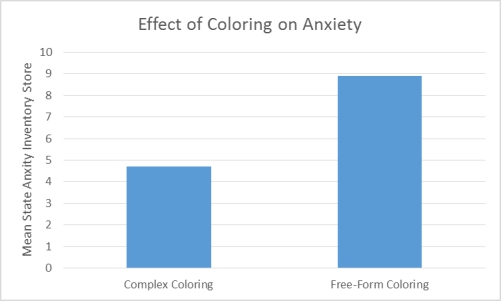Use the following to answer questions
Scenario I
Scenario I is based on fabricated data inspired by the following study:
Curry,N.A.& Kasser,T.(2005) .Can coloring mandalas reduce anxiety? Art Therapy: Journal of American Art Therapy Association,22(2) 81-85.
Effect of Coloring on Anxiety
Curry and Kasser were interested in examining whether coloring complex geometric patterns reduces anxiety.To that end,they induced anxiety in 84 undergraduate volunteers from their university.Following anxiety induction the participants were divided into two coloring conditions.To determine which condition each participant would be in the researchers put all of their names in a hat.The first name drawn was placed in group 1,the second name drawn was placed in group 2,the third name drawn was placed in group 1,and so on.Those in the complex geometric coloring condition (group 1) were given a paper with a plaid pattern or the outline of a mandala.Those in the control condition (group 2) were given a blank piece of paper.After 20 minutes of coloring all of the participants completed a self-administered State Anxiety Inventory (SAI) .Lower SAI scores indicate low levels of anxiety whereas higher SAI scores indicate high levels of anxiety.The mean SAI scores of each coloring condition were compared to determine whether the type of coloring one does affects anxiety.The results revealed that those who colored a complex geometric pattern had significantly different levels of anxiety than those who colored on a blank sheet of paper.Curry and Kasser concluded that coloring causes a change in anxiety,but only when coloring requires a certain amount of attention and focus.
Figure 1.Effect of Coloring on Anxiety

-(Scenario I) In this study,researchers identified a relationship between coloring and anxiety reduction.They were able to conclude that coloring a complex pattern causes anxiety to decrease because of:
A) covariation.
B) temporal precedence.
C) independence.
D) internal validity.
Correct Answer:
Verified
Q44: Use the following to answer questions
Scenario I
Scenario
Q45: Use the following to answer questions
Scenario I
Scenario
Q46: Use the following to answer questions
Scenario I
Scenario
Q73: Use the following to answer questions
Scenario III
Scenario
Q78: Use the following to answer questions
Scenario II
Scenario
Q101: (Scenario II) Regardless of their assigned treatment
Q102: (Scenario II) Suppose the researchers manipulated the
Q107: (Scenario III) The experimental group in Scenario
Q112: (Scenario II) Based on the information provided
Q118: (Scenario III) The null hypothesis of the
Unlock this Answer For Free Now!
View this answer and more for free by performing one of the following actions

Scan the QR code to install the App and get 2 free unlocks

Unlock quizzes for free by uploading documents